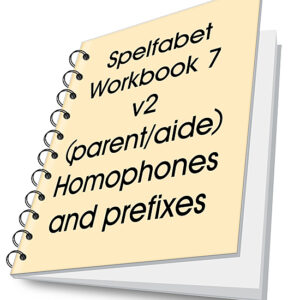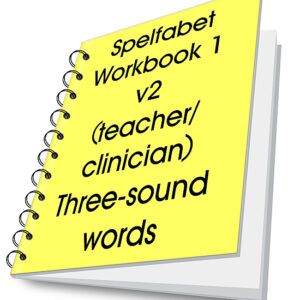Workbook 3 – teacher/clinician version
$AUD26.90
Description
121 pages of synthetic phonics activities designed for learners of any age who can write one-syllable words with “short” vowels and associated consonant spellings, and now need to learn major vowel digraphs and syllable types, and how to manage the unstressed vowel (schwa) when spelling. View the workbook’s video tour here. Download a free sample of the workbook here.
This workbook contains very straightforward activities that follow the same cycles, so you don’t need special training or expertise to help a learner use it. It walks you through the task of writing two-syllable words, recycling the sounds and spellings from the first two workbooks, and adding the following concepts/spellings:
- Compound words
- Unstressed vowels in closed syllables
- “short” versus “long” vowel contrasts as in cap/cape, them/theme, pin/pine, hop/hope, cut/cute.
- CVCe word/syllable practice: a…e as in take, e…e as in these, i…e as in time, o…e as in home, u…e as in tune or June.
- c as in cell
- g as in gem
- a as in apron
- e as in evil
- i as in kind and giant
- o as in both and hippo
- u as in emu
- u as in scuba
- y as in cry
- y as in baby
- rr as in parrot
- Doubled consonants as in bunny, cherry, skivvy
- i as in ski
- Contractions as in he is = he’s
- Words ending in ing (present progressive verbs)
- Words ending in le as in bottle, bridle
- ai as in rain
- ee as in see
- ea as in sea
- oo as in moon
- er as in her
- er as in father
- ar as in car
- ar as in collar
- or as in north
- or as in mirror
- ou as in out
- “short” versus “long” vowel contrasts as in dinner/diner, holly/holy, supper/super
- a as in above
- a as in sofa
- e as in escape
- r as in fire and cure
- r as in culture
- Words with a written syllable we don’t usually pronounce e.g. chocolate, Wednesday
- Homographs as in “They record a record”.
All activities incorporate pictures, to add meaning and build vocabulary. Pictures are mostly simple, computer-generated line drawings from the Mayer-Johnson Picture Communication Symbols, and are used with permission. They are suitable for all ages.
This workbook should be used in conjunction with other synthetic phonics activities at the same skill level, such as the games on this website, the movable alphabet, decodable books and relevant apps/software. To make good progress, your learner should do three to five practice sessions a week, ideally completing one or two sets of workbook words at a time, then do some reading, games, wordbuilding etc. at the same level.
Please note that this workbook is supplied as a pdf file which you download and print yourself. This keeps it affordable. Please print on scrap paper if you can, to save trees. You can purchase using a credit card, you don’t need a PayPal account.
The workbook comes with a cheat sheet listing all the words in the workbook and suggested sentences for each, so you don’t have to figure out what the target words are, and can work quickly. The aim is that your learner has lots of practice listening to spoken words, saying them in a stretched-out way, discriminating their sounds, matching the sounds to the correct letters/spellings, and writing them with correct placement and formation.
You may make up to fifty copies of this workbook, for use with your own students/clients. You might consider it most suitable as a simple, hard-to-get-wrong homework activity, and just check it each week/session.







